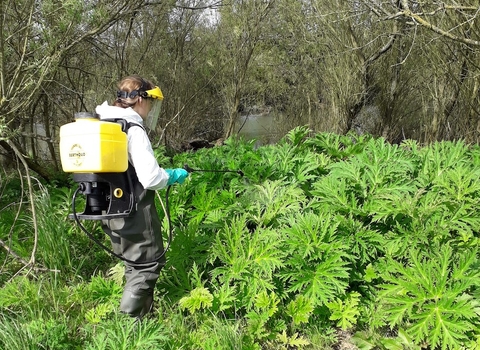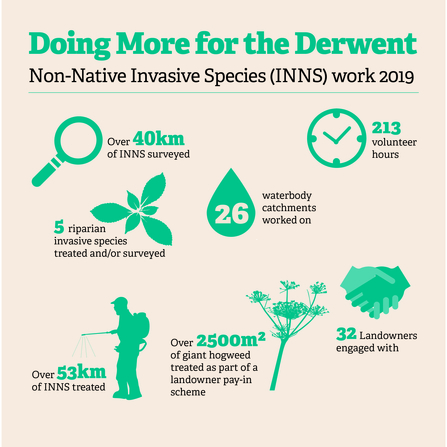Improving the Derwent for people and wildlife
We are working with the Environment Agency on their Doing More for the Derwent project, which aims to improve the ecological health of the River Derwent. The work focuses on the stretch of the Derwent which is a designated Site of Special Scientific Interest (SSSI).
Our work on the project is varied, from tackling Invasive Non-Native Species (INNS) in the catchment to reducing the amount of sediment that is washed into the Derwent from nearby land and creating new wetland nature reserves.
Identifying and reducing sources of sediment
We have been working in partnership with the Environment Agency and Natural England to reduce sediment entering the River Derwent.
We carried out sediment walkover surveys in 2017, 2019 & 2020. These surveys are designed to identify sources, or potential sources, of fine sediment entering the river. Walking along a watercourse during the winter, especially after it has rained, is a great way to identify issues and think about methods to reduce this runoff.
We have worked closely with landowners offering advice on how to reduce sediment inputs and improve health of soil and explaining the negative impact it can have on our habitats and wildlife.
The project has also funded some improvement works to reduce sediment entering the river. These include fencing alongside rivers and streams that enter the Derwent, to reduce poaching and protect the riverbank from livestock. We've also installed sediment traps which help to slow water flow into the river, and collect fine sediment before it enters the watercourse.

Tackling invasive non-native species (INNS)
In 2017, the Environment Agency commissioned us to create a catchment-wide strategy to tackle invasive non-native species (INNS). This involved mapping out the distribution of invasive plants such as giant hogweed, Himalayan balsam and Japanese knotweed.
The primary focus of our treatment plan is the eradication of giant hogweed. It is notable for its large size, towering over other herbaceous plants, and impressive umbel flowers. Giant hogweed outcompetes native flora and has a fearsome reputation for causing burns on human skin, caused by its phototoxic sap.
Staff and trained volunteers have carried out spraying and stem injection of giant hogweed, mainly in the middle Derwent where the infection is the most severe.
The catchment-wide strategy identified the distribution of INNS and set out priority treatment areas. As seeds from the invasive plants travel downriver, we prioritised infection sites higher in the catchment.
Trained volunteers have been busy across the Derwent catchment, surveying areas where there is little or no INNS data. This information is vital to help us update our control strategy and carry out more effective treatment.
We trialled a pay-in scheme in 2019, where landowners were approached to contribute towards the treatment of giant hogweed on their land. We engaged with 32 landowners and following this, 2500m² of INNS were treated. There are plans to expand the pay-in scheme in future years to encourage land owners to control INNS on their own land, and reduce the reliance on external funding to prevent spread.
Our work focusses mainly on eradicating giant hogweed. Other partners including the Howardian Hills Area of Outstanding Natural Beauty (AONB) and the North York Moors National Park have treated Himalayan balsam higher in the catchment. Himalayan and orange balsam pulling is carried out by volunteer groups in priority areas. We also treat a small amount of Japanese knotweed in the Derwent SSSI.
Biosecurity
Good biosecurity is of significant importance in the catchment, particularly in areas where there are vulnerable species such as white-clawed crayfish.
We adhere to strict biosecurity procedures when working in the catchment to protect what is there and prevent the spread of INNS and other harmful species between sites.
Throughout all work undertaken, Yorkshire Derwent Catchment Partnership carried out biosecurity procedures based on Yorkshire Invasive Species Forum’s best practice guide.


Barmby on the Marsh Wetlands
Barmby on the Marsh Wetlands is a small wetland nature reserve, located at the meeting point between the River Derwent and River Ouse, and acts as a safe haven for wildlife.
We have helped to restore Barmby on the Marsh by removing willow which had started to dominate the site and dry it out. Thanks to our work, we're already seeing record numbers of wetland birds returning!
Doing More for the Derwent
Funder
Environment Agency (Doing More for the Derwent project)
Timescale
Ongoing

